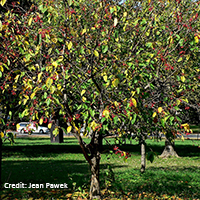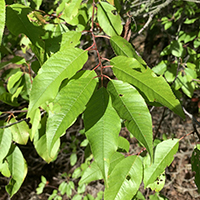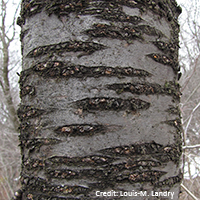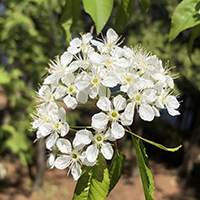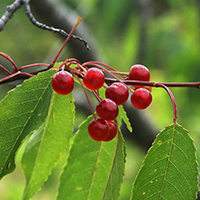What pin cherry looks like
Size and shape
- Reaches 12 metres high.
- Trunk reaches up to 25 centimetres in diameter.
Leaves
- Shiny and yellowish green with toothed margins (8 to 15 centimetres).
- Taper into a sharp tip.
- Have a rounded base and commonly curve backwards.
- Turn purple to red in fall.
Bark
- Smooth reddish-brown with orange pores.
- Horizontal strips form with age.
Flowers
- White and grow in clusters of 4 to 7.
- Bloom in early spring.
Fruit
- Bright red fruit (6 to 8 millimetres) grows on thin stalks.
- Fruit is edible but sour.
- Ripen between July and early September.
Where pin cherry is found
Pin cherry is found throughout Ontario except in the Far North.
What you need to know to grow pin cherry
- Moisture: grows in most soil moistures.
- Soil: grows in most soil types.
- Shade: requires full sun.
- Caution: non-fruit parts of the tree contain toxins.
Benefits and uses of pin cherry
Wildlife benefits
Pin cherry fruits are eaten by more than 25 species of birds, including:
- blue jays
- robins
- cardinals
- wild turkeys
Many mammals eat the fruit and white-tail deer browse twigs and leaves.
Commercial uses
Pin cherry trees have little commercial value but can prevent erosion in burned or clear-cut areas. Fruits are often used to make jelly or syrup and the wood can be used to produce paper.
Fun facts about pin cherry
- Pin cherry trees can live up to 40 years.
- Pin cherry fruits are so popular with birds that the tree is often called bird cherry.
- Pin cherry seeds will still germinate after many decades in soil.
Updated: January 10, 2024
Published: July 18, 2014
